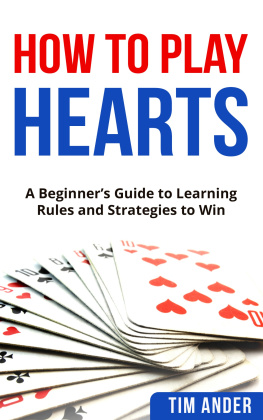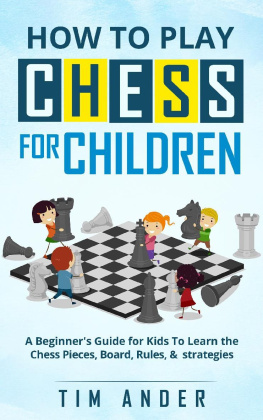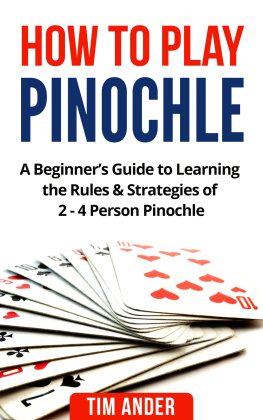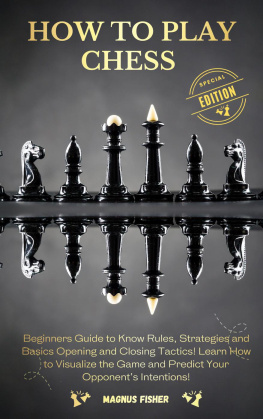HOW TO PLAY HEARTS
A Beginners Guide to Learning Rules and Strategies to Win

Tim Ander
Copyright 2018 by Tim Ander .
All rights reserved.
No part of this publication may be reproduced, distributed, or transmitted in any form or by any means, including photocopying, recording, or other electronic or mechanical methods, without the prior written permission of the publisher, except in the case of brief quotations embodied in critical reviews and certain other noncommercial uses permitted by copyright law.
For permission requests, please contact the publisher.
Contents
Introduction
What is Hearts?
Hearts is a trick-taking game, but unlike most trick-taking games, it is a game of evasion. In most cases, players are penalized for taking tricks, so try to lose as many tricks as possible. It is a game which is typically played with 4 players, though it can be modified to be played with 3, 5, and 6 players. It is a member of the Whist family and is a good gateway game to the more complex trick-taking games. It is made unique by the evasion style strategy of the game, but if you can take every single trick, then the other players are penalized instead of you. In some cases, it can be a game of limiting your losses. In other instances, it can be a game of all or nothing.
Players play with a standard deck of cards, and the cards are distributed evenly among the 4 players (4 players makes this even distribution possible). There is a phase where 3 cards are passed to another player. Players then take turns leading cards, depending on who dealt and who won the previous trick. The player who played the highest card in relation to the suit which was led wins the trick. Players are penalized for winning hearts in a trick and also the queen of spades.
At the end of the hand, players score their cards depending on the cards they have. The penalty points are added to their score, and the player with the lowest score is said to be in the lead. Play generally continues until a player reaches a predetermined score (usually 100 points). At that point, the player with the lowest score wins.
History of Hearts
The history of Hearts belongs in 18th Century Spain. In 1750, the game of Reversis was a popular game of the time. In the game, penalty points were awarded for the taking of a trick as well as capturing penalty cards. As more penalty cards were added to the game, it slowly evolved into the game of Hearts we know today. Around 1850, the game became almost identical to the game we play and enjoy around the world today. The final additions to the game were the queen of spades as a penalty card and the penalty points being expressed as positive instead of negative. The idea of shooting the moon (trying to capture all the penalty cards and penalize the other players) was also a late addition.
The game is especially popular in Canada, online, and for anyone who owned a 90s version of Microsoft Windows. It came as standard with the operating system and many hours were spent by many people, playing the game.
How To Play Hearts
Getting started
What do you need before you can play a game of Hearts? Firstly, you need a standard deck of cards. In Hearts, the cards are ranked from high to low, with Ace being high and 2 being low. The jokers are not used in the traditional 4-player game, which we will discuss here. You also need 3 other players to play with you. You can play with less than 4 players and more than 4 players, but the game is at its best when 4 players are playing. Find 3 of your friends and invite them around. You also need a playing surface. You need enough room for four hands of cards to be dealt out and for cards to be played in the center. Lastly (and this is completely optional), you need to have some drinks and snacks. A good game of cards is always better with drinks and snacks. Especially if you have friends round to play. Once you have all that, you can begin the game.
Object of the game
Hearts is a trick-taking game, but it is a game of evasion. The idea is to avoid taking tricks which contain the penalty cards. The less your score at the end of a round, the better. The lowest score at the end of the game wins. There is merit in taking some tricks to be able to lead, but if you can take fewer penalty cards than your opponents, then you will win the game.
Penalty cards
In the standard game of Hearts, there are penalty cards. Each of the hearts are worth 1 point. The queen of spades counts as 13 points. There are 26 points upper grabs in each hand. At the end of the hand, players will count the number of hearts they have and give themselves a point. If you have the queen of spades, then you award yourself points. There is a way, though, to win penalty cards without taking points. If you manage to take all 13 hearts and the queen of spades, instead of you being penalized 26 points, you score 0, and all your opponents score 26 points. This is known as shooting the moon.
The deal
Now that you have your friends, a deck of cards, a playing surface, snacks, drinks, and know the basic object of the game, you can deal the cards. The very first thing you need to do is choose who deals the cards first. You can do this by drawing cards from the deck or dealing a card to each player. The player with the highest card will be the first dealer. If two players receive the same high card, then continue dealing until one player has the highest card.
The first dealer should then take up all the cards and shuffle them. Once shuffled, the dealer should pass the cards to the player to the right to be cut. The player to the right can choose to cut the cards or leave them as they are. Once the decision has been made, the dealer can deal. Starting with the player to their left, the dealer deals the cards out, one at a time, to each player. This continues until all the cards have been dealt out. Each player should now have 13 cards. On the next hand, the player to the left of the dealer will become the next dealer. The deal continues in a clockwise direction around the table, until the end of the game.
Passing
Before any gameplay begins, there is a passing phase. In the most basic rules of Hearts, passing is not incorporated, but it has become such a popular part of the game that it a rule which is usually added to the game. I will be incorporating the passing phase into this book as a standard rule of the game.
During the passing phase, each player must pass 3 cards. With 4 players, the way in which you pass the cards can vary. Here are the two most common variants:
- You can pass the cards to the player to your left. This means that you will be passed cards from the player to your right.
- You can alternate the player you pass the cards to. On your first hand, each player will pass cards to the left. On the next hand, each player will pass cards to the opponent across from them. On the next hand, each player will pass cards to the right. The sequence then repeats until the end of the game.
The way in which you pass the cards is entirely up to you and should be agreed upon before the game starts. There are a couple of important points to note when passing cards. Each player must pass three cards. The cards can be any three cards of their choosing. All players must choose the three cards and place them face-down on the table before they are passed to the player. Once all 4 players have chosen their cards, and they are face-down on the table, they can be passed. Players cannot look at the cards they have been passed before choosing the cards they wish to pass.
Next page














